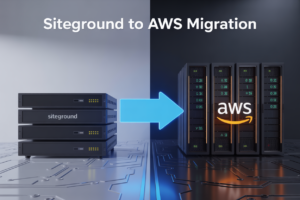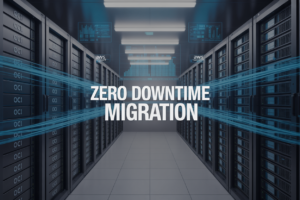Modern cloud deployments don’t have to be a manual nightmare of clicking through AWS consoles and praying nothing breaks. AWS Terraform deployment combined with GitHub Actions CI/CD transforms your infrastructure management into a smooth, automated process that saves time and reduces human error.
This guide is designed for DevOps engineers, cloud architects, and development teams who want to streamline their AWS infrastructure automation without getting lost in complex configurations. You’ll learn practical techniques that work in real production environments, not just toy examples.
We’ll walk through setting up your GitHub Actions workflow Terraform pipeline from scratch, showing you exactly how to build reliable automated cloud deployment processes. You’ll also discover advanced error handling strategies and monitoring techniques that keep your cloud infrastructure pipeline running smoothly, even when things go sideways.
By the end, you’ll have the knowledge to implement bulletproof infrastructure as code automation that your team can depend on for consistent, repeatable deployments.
Understanding the Power of Terraform for AWS Infrastructure Management
Eliminate Manual Configuration Errors and Reduce Deployment Time
Manual AWS infrastructure setup leads to human errors, inconsistent configurations, and hours of repetitive work. Terraform AWS deployment automates these processes through declarative code that eliminates guesswork. Teams can deploy complex environments in minutes instead of hours, with every resource configured identically across deployments. Infrastructure provisioning becomes predictable and reliable.
Achieve Consistent Environment Provisioning Across Development Stages
Development, staging, and production environments often drift apart when managed manually, creating deployment failures and debugging nightmares. Terraform infrastructure as code automation ensures identical configurations across all stages. The same code that builds your development environment deploys to production, removing the “it works on my machine” problem completely.
Maintain Version-Controlled Infrastructure as Code
Traditional infrastructure documentation becomes outdated quickly, leaving teams confused about current configurations. Terraform treats infrastructure like application code, storing everything in version control systems. Teams can track changes, review modifications before deployment, and roll back problematic updates instantly. Every infrastructure change becomes auditable and reversible through standard Git workflows.
Scale Resources Efficiently with Declarative Syntax
Terraform’s declarative approach lets you describe desired infrastructure state without specifying step-by-step procedures. Need to scale from two servers to twenty? Simply update the count parameter and apply changes. Terraform calculates dependencies automatically, creating resources in the correct order and handling complex relationships between services without manual intervention or scripting.
Setting Up Your GitHub Actions Workflow for Automated Deployments
Configure Repository Structure for Terraform Projects
Create a standardized directory structure that separates environments, modules, and configurations for optimal AWS Terraform deployment management. Organize your repository with dedicated folders for /environments/dev, /environments/staging, and /environments/prod, alongside a /modules directory for reusable infrastructure components. This structure supports scalable infrastructure as code automation and simplifies maintenance across multiple deployment stages.
Create Secure AWS Credentials Integration
Set up GitHub repository secrets to store AWS credentials securely without exposing sensitive information in your code. Navigate to your repository settings, add AWS_ACCESS_KEY_ID and AWS_SECRET_ACCESS_KEY as encrypted secrets, and configure IAM roles with minimal required permissions for Terraform AWS pipeline operations. Use OpenID Connect (OIDC) providers when possible to establish secure, temporary credential access that eliminates long-lived access keys and enhances your GitHub Actions CI/CD security posture.
Design Multi-Stage Pipeline Architecture
Build a comprehensive GitHub Actions workflow Terraform pipeline that includes validation, planning, and deployment phases across multiple environments. Start with Terraform format checks and validation in the initial stage, followed by terraform plan for change review, and conclude with conditional terraform apply based on branch protection rules. Implement environment-specific workflows that trigger automated cloud deployment processes only after successful testing and approval gates, ensuring your cloud infrastructure pipeline maintains reliability and prevents unauthorized changes to production resources through robust DevOps automation AWS practices.
Building Robust Terraform Configurations for Production Environments
Implement Modular Resource Organization
Breaking your AWS Terraform deployment into logical modules transforms chaotic infrastructure code into maintainable components. Create separate modules for networking, compute, storage, and security resources. Each module should handle a single responsibility – your VPC module manages subnets and route tables while your EC2 module focuses solely on compute instances. This approach enables teams to work independently on different infrastructure layers without conflicts. Structure modules with clear input variables and outputs that other modules can consume. When building your GitHub Actions workflow Terraform pipeline, modular organization allows selective deployments and faster troubleshooting during automated cloud deployment processes.
Configure State Management with Remote Backends
Remote state backends prevent the nightmare of corrupted local state files that can destroy entire AWS environments. Configure S3 with DynamoDB locking for your Terraform AWS pipeline to ensure state consistency across team members and CI/CD systems. Enable versioning on your S3 bucket to recover from accidental state corruption. Set up proper IAM policies that restrict state file access to authorized users and GitHub Actions workflows only. Your infrastructure as code automation depends on reliable state management – local state files have no place in production deployments. Remote backends also enable state sharing between different Terraform configurations and provide audit trails for infrastructure changes.
Apply Security Best Practices for AWS Resources
Security hardening starts with IAM roles that follow least-privilege principles throughout your DevOps automation AWS setup. Never embed access keys directly in Terraform files – leverage GitHub secrets and assume roles instead. Enable encryption at rest for all data stores including RDS, S3, and EBS volumes. Configure security groups with specific port ranges rather than allowing all traffic. Implement AWS Config rules and CloudTrail logging to monitor resource compliance automatically. Your automated cloud deployment pipeline should include security scanning tools that validate configurations before applying changes. Use AWS Secrets Manager for database credentials and API keys that Terraform modules need during provisioning.
Establish Variable Management Strategies
Variable management separates configuration from code, enabling the same Terraform modules to work across development, staging, and production environments. Use terraform.tfvars files for environment-specific values while keeping sensitive data in GitHub secrets or AWS Parameter Store. Implement variable validation rules to catch configuration errors before deployment starts. Structure variables hierarchically – global settings at the root level and environment-specific overrides in subdirectories. Your cloud infrastructure pipeline becomes more reliable when variables have clear naming conventions and comprehensive descriptions. Consider using workspace-specific variable files when managing multiple environments within the same GitHub Actions CI/CD workflow.
Create Reusable Module Libraries
Building reusable module libraries accelerates future AWS infrastructure automation projects while maintaining consistency across your organization. Design modules with configurable parameters that adapt to different use cases without code duplication. Publish your tested modules to private Terraform registries or separate Git repositories with proper versioning. Document module inputs, outputs, and usage examples thoroughly so other teams can adopt them quickly. Your GitHub Actions workflow Terraform processes benefit from battle-tested modules that reduce deployment failures. Include validation logic within modules to prevent misconfiguration and provide clear error messages when invalid parameters are passed during infrastructure provisioning.
Implementing Continuous Integration and Deployment Pipelines
Automate Terraform Plan Generation and Review Process
Building a solid GitHub Actions CI/CD pipeline starts with automating your Terraform plan generation. Set up workflows that trigger on pull requests, automatically running terraform plan and posting results as PR comments. This infrastructure as code automation approach lets your team review proposed changes before deployment. Configure the workflow to store plan files as artifacts, enabling seamless handoffs between planning and deployment stages. Use GitHub’s native review features to require approvals on infrastructure changes, creating a safety net that prevents unauthorized modifications to your AWS Terraform deployment pipeline.
Execute Conditional Deployments Based on Branch Strategies
Smart branching strategies power effective Terraform continuous deployment workflows. Configure your GitHub Actions workflow Terraform setup to deploy automatically from main branches while requiring manual approval for staging environments. Use conditional logic in your workflows to determine deployment targets based on branch names or tags. Development branches might deploy to sandbox environments, while production deployments only trigger from tagged releases. This DevOps automation AWS approach ensures consistent environments while maintaining control over critical infrastructure changes. Set up environment-specific variable files and Terraform workspaces to manage multiple deployment targets seamlessly.
Integrate Automated Testing for Infrastructure Changes
Robust cloud infrastructure pipeline implementations include comprehensive testing at every stage. Integrate tools like Terratest or kitchen-terraform into your GitHub Actions workflows to validate infrastructure changes before deployment. Run compliance checks using tools like Checkov or tfsec to catch security issues early in the development cycle. Set up automated drift detection that compares your actual AWS infrastructure automation state against Terraform configurations. Include integration tests that verify deployed resources meet functional requirements. This multi-layered testing approach catches issues before they reach production, making your automated cloud deployment pipeline more reliable and reducing the risk of infrastructure failures affecting your applications.
Advanced Workflow Optimization and Error Handling
Implement Rollback Mechanisms for Failed Deployments
Automated rollback strategies protect your AWS Terraform deployment pipeline when things go wrong. Configure your GitHub Actions workflow to store previous infrastructure states and automatically trigger rollbacks when deployment failures occur. Use Terraform’s workspace functionality to maintain separate environments and implement blue-green deployment patterns that allow instant switching between infrastructure versions. Set up conditional steps in your CI/CD pipeline that detect failed apply operations and execute predefined rollback procedures, ensuring your production environment stays stable even when new changes introduce problems.
Configure Notification Systems for Deployment Status
Real-time alerts keep your team informed about infrastructure changes and deployment outcomes. Integrate Slack, Microsoft Teams, or email notifications directly into your GitHub Actions workflow using webhook actions and conditional triggers. Configure different notification channels for various deployment stages – success notifications for stakeholders, failure alerts for engineering teams, and detailed logs for debugging purposes. Include deployment summaries with resource changes, cost implications, and rollback instructions in your notifications to provide actionable information when manual intervention becomes necessary.
Optimize Pipeline Performance and Resource Usage
Speed up your AWS infrastructure automation by implementing smart caching strategies and parallel execution patterns. Cache Terraform providers, modules, and plan files between workflow runs to reduce initialization time. Use GitHub Actions matrix builds to deploy multiple environments simultaneously and configure resource-specific jobs that only run when relevant files change. Implement plan-only workflows for pull requests and full apply operations for main branch merges, reducing unnecessary resource consumption while maintaining deployment reliability and faster feedback loops.
Handle Terraform State Conflicts and Concurrent Modifications
State file conflicts can break your entire deployment pipeline if multiple team members or automated processes try to modify infrastructure simultaneously. Configure remote state backends with DynamoDB locking to prevent concurrent modifications and ensure state consistency across your team. Implement retry mechanisms in your GitHub Actions workflow that handle temporary state locks gracefully. Set up monitoring for state file corruption and establish backup procedures that automatically save state snapshots before major infrastructure changes, giving your team recovery options when state conflicts occur.
Monitoring and Maintaining Your Automated Infrastructure Pipeline
Track Deployment Metrics and Success Rates
CloudWatch dashboards become your command center for monitoring GitHub Actions workflow Terraform deployments across AWS environments. Set up custom metrics tracking deployment frequency, success rates, and pipeline duration to identify bottlenecks in your infrastructure as code automation. Configure SNS notifications for failed deployments and establish baseline performance indicators that alert your team when AWS Terraform deployment patterns deviate from normal operations.
Implement Cost Optimization Through Automated Resource Management
Automated cloud deployment pipelines should include cost governance controls that prevent runaway infrastructure spending. Deploy AWS Cost Explorer APIs within your Terraform continuous deployment workflows to automatically tag resources, set billing alerts, and implement auto-scaling policies. Schedule Lambda functions to identify unused EC2 instances, orphaned EBS volumes, and oversized RDS databases, creating pull requests that optimize your DevOps automation AWS infrastructure without manual intervention.
Establish Regular Security Audits and Compliance Checks
Security scanning must be baked into your cloud infrastructure pipeline from day one. Integrate tools like Checkov, TFSec, and AWS Config Rules directly into your GitHub Actions CI/CD workflows to catch misconfigurations before they reach production. Run weekly compliance reports against CIS benchmarks, SOC2 requirements, and your organization’s security policies, automatically creating GitHub issues for any violations discovered in your Terraform AWS pipeline configurations.
Terraform and GitHub Actions create a powerful combination that transforms how teams manage AWS infrastructure. By automating your deployments through well-structured workflows, you eliminate manual errors, speed up releases, and maintain consistent environments across your entire development lifecycle. The key lies in building solid Terraform configurations, setting up reliable CI/CD pipelines, and implementing proper monitoring practices that catch issues before they impact your production systems.
Ready to take your AWS infrastructure management to the next level? Start small by automating a single environment, then gradually expand your pipeline to handle more complex deployments. Remember to prioritize security best practices, implement comprehensive error handling, and keep your team informed about pipeline changes. With these automation tools in place, you’ll spend less time wrestling with manual deployments and more time building features that matter to your users.




















